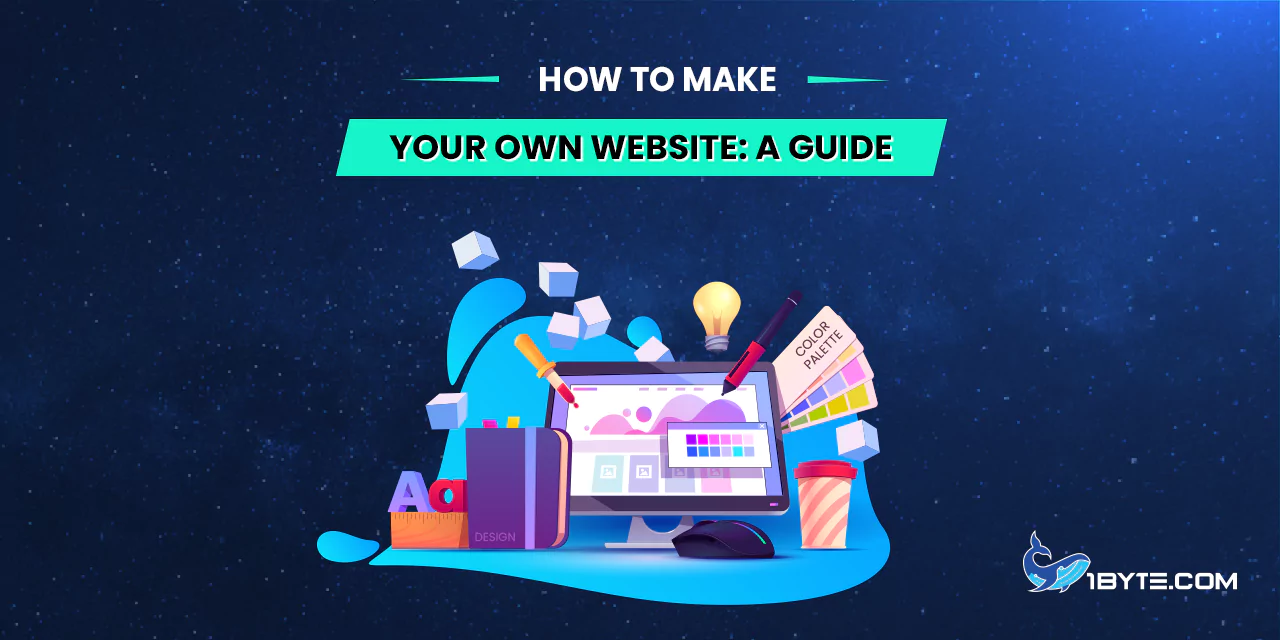In today’s digital age, knowing how to make your own website is an invaluable skill. This guide provides step-by-step instructions for beginners, ensuring that creating your website is both accessible and achievable. Whether you’re launching a personal blog, an online portfolio, or a small business site, this comprehensive guide will walk you through the process, empowering you to craft your corner of the web effortlessly. Let’s dive in and turn your website dream into a reality.
The importance of creating your own website
In today’s digital landscape, understanding how to make your own website is not just a valuable skill; it’s an essential one. Let’s delve into why having your website matters.
Firstly, a website serves as your digital storefront, and it’s open around the clock. When potential customers or visitors want information about your business, interests, or expertise, they often turn to the internet. Having a website ensures that you are accessible to them whenever they search.
Furthermore, a website allows you to establish a robust online presence. It acts as your online identity, representing you or your business to the world. You have complete control over its appearance, content, and functionality, which means you can tailor it to reflect your unique style, message, and brand.

Moreover, a website is a powerful communication tool. It enables you to convey information, showcase your skills, or present your products and services to a global audience. This ability to share your message effectively can help you connect with potential customers, clients, or like-minded individuals, fostering trust and credibility.
Versatility is another key advantage of having a website. You can use it for various purposes, such as blogging, e-commerce, sharing your portfolio, or building a personal brand. The adaptability of a website makes it a valuable asset for both individuals and businesses.
Not having a website in today’s competitive online landscape is akin to missing out on countless opportunities. It limits your visibility, reduces your reach, and hinders your ability to connect with your target audience. In contrast, learning how to make your own website empowers you to harness the full potential of the internet and make your mark in the digital world.
The statistics say it all
Understanding the importance of knowing how to make your own website becomes even more evident when you consider the compelling statistics that surround the digital landscape. Let’s delve into these numbers and see why having your website is crucial.
- First Impressions Matter: In the blink of an eye, or precisely in about 50 milliseconds (that’s 0.05 seconds), users form their initial impression of your website. This lightning-fast judgment can determine whether they like your site or not and whether they’ll decide to stay and explore further or leave immediately. It highlights the critical role that website design and user experience play in capturing and retaining the attention of your audience.
- Mobile User Experience: The importance of a seamless mobile user experience cannot be overstated. According to Google, a staggering 61% of users are unlikely to return to a website on their mobile devices if they encounter difficulties accessing or navigating it. What’s more, 40% of them may even opt to visit a competitor’s site instead. These statistics underscore the need for responsive and mobile-friendly website design in an era where mobile browsing is ubiquitous.
- Local Business Impact: For businesses with a local presence, the digital realm has a profound influence. A remarkable 88% of consumers who search for a specific type of business on a mobile device are likely to take immediate action, such as making a phone call or visiting the business’s physical location, within 24 hours. This demonstrates the significant impact that your website can have on driving foot traffic and conversions for local businesses.
- Design Matters: The visual appeal and layout of your website hold immense sway over user engagement. A striking 38% of people admit that they will stop engaging with a website if they find its content or layout unattractive. This emphasizes the importance of creating visually appealing and user-friendly websites to capture and retain the interest of your audience.
- Business Presence: The sheer scale of the digital landscape is awe-inspiring. As of now, there are approximately 1.13 billion websites on the internet, and a new website is created every three seconds. This exponential growth highlights the fierce competition for online visibility and underscores the necessity of having a website to stand out in this vast digital expanse.
- Business Adoption: In 2023, a remarkable 71% of businesses have embraced the digital frontier and established their online presence through websites. This notable increase can be largely attributed to the transformative impact of the Covid-19 pandemic, which accelerated the shift towards digitalization in various industries.
- Online Business Activity: The digital world has become a thriving hub for commercial activities. Recent statistics reveal that 28% of all business transactions and interactions now take place online. This trend signifies a fundamental shift in consumer behavior, highlighting the significance of having a strong online presence and the potential for growth and expansion through digital channels.
- Consumer Behavior: Consumer behavior has evolved significantly in the digital age. According to the eCommerce Foundation, a staggering 88% of consumers conduct thorough product research before making a purchase, whether it’s online or in a physical store. This underscores the critical role that your website can play as a primary source of information for potential customers.
- Web Design Importance: In a world where time is precious, the importance of web design becomes evident. When given only 15 minutes to consume content, a substantial 66% of people express a preference for beautifully designed content over something plain and simple. This preference highlights the impact that an aesthetically pleasing website can have in capturing and retaining the attention of your audience, even in a time-constrained environment.
Recommended reading: A Guide to Effective Cloud Orchestration
How to Make Your Own Website: 7 Steps
Creating your website is an achievable goal, and this guide will show you precisely how to make your own website. In just seven easy steps, you’ll be on your way to establishing a strong online presence. Let’s dive right in and explore the process of bringing your website to life.
Choosing a Website Building Platform
When it comes to learning how to make your own website, one of the pivotal decisions you’ll face is selecting the right website building platform. In making this crucial choice, you need to ensure that your website’s foundation aligns perfectly with your goals and aspirations.
Popular website building platforms
When it comes to making your own website, the choice of a website building platform is pivotal. Here’s a concise overview of popular options to consider:
- Wix: Known for its versatility, Wix offers a wide range of free features. Its user-friendly interface and a variety of templates make it a top choice for many.
- GoDaddy: If you’re new to website building, GoDaddy is beginner-friendly and lets you establish your online presence quickly. It’s praised for its design flexibility and robust marketing and SEO tools.
- Squarespace: Squarespace shines with image-heavy websites and provides excellent value for money. It’s an ideal choice for creatives and those who want to personalize their websites extensively.
- Web.com: Offering design flexibility and speedy website creation, Web.com is a popular choice. It’s also well-regarded for its hosting options.
- Hostinger: With an excellent uptime record and AI-powered tools, Hostinger is a reliable choice for website builders.
- Weebly: Weebly is renowned for its easy-to-use page editing features and is often considered the best overall website builder.
- Shopify: If you’re focused on creating a scalable online store, Shopify is the go-to platform.
- WordPress.com: For bloggers, WordPress.com remains the top choice, offering powerful features for content creators.
- 1Byte: As a top cloud computing and web hosting provider, we offer a versatile platform that supports both website building and hosting.
- Duda: Popular among agencies, Duda stands out for its seamless integration with SaaS platforms.
Each platform has its strengths, making it crucial to assess your needs and preferences when selecting the one that aligns best with your vision for your website.
Selecting a Domain Name
Choosing the right domain name is a critical step in learning how to make your own website. Here’s a straightforward guide on how to do it effectively.

- Reflect Your Identity: Your domain name is your digital identity. It should mirror your website’s purpose, brand, or content. Make it easy to remember.
- Keep It Short: Short domain names are easier to type and remember. Aim for brevity without sacrificing clarity.
- Avoid Hyphens and Numbers: Hyphens and numbers can confuse visitors and make your domain harder to share verbally.
- Use Keywords Wisely: Incorporate relevant keywords into your domain name if possible. This can boost your website’s search engine visibility.
- Check Availability: Ensure that your chosen domain name is available. Many domain registrars offer search tools to help you find an available name.
- Consider the Extension: The domain extension, like .com, .net, or .org, should match your website’s purpose. .com is a popular choice for general websites.
- Trademark Awareness: Check for trademarks related to your domain name to avoid legal issues.
- Think Long-Term: Your domain name is a long-term commitment. Choose one that you won’t outgrow as your website evolves.
- Avoid Trendy Slang: Trends change quickly. Steer clear of trendy phrases or slang that might become outdated.
- Ask for Feedback: Get input from friends, colleagues, or potential visitors to ensure your domain name resonates with your target audience.
By following these steps, you can select a domain name that not only represents your website effectively but also stands the test of time in the ever-evolving digital landscape.
Setting Up Hosting
Now that you’ve chosen your domain name, the next step in learning how to make your own website is setting up hosting. Here’s a simple guide to help you get started.
- Select a Hosting Provider: Begin by choosing a reliable hosting provider. Look for one that suits your needs and budget.
- Sign Up: Visit the hosting provider’s website and sign up for an account. This typically involves providing your contact information and payment details.
- Choose a Hosting Plan: Hosting providers offer various plans with different features. Pick the plan that aligns with your website’s requirements.
- Configure Your Domain: Connect your domain name to your hosting account. Most hosting providers offer step-by-step instructions to simplify this process.
- Set Up Your Website: Once your domain is connected, it’s time to set up your website. Some hosting providers offer website builders that make this process user-friendly.
By following these steps, you’ll have your website hosted and ready for customization. Hosting is the foundation that ensures your website is accessible to users across the internet, making it a crucial aspect of the website creation process.
Designing Your Website
Designing your website is a crucial step in mastering how to make your own website. Here’s a clear guide to help you create an appealing and user-friendly design.
- Select a Template or Theme: Begin by choosing a template or theme that matches your website’s purpose. Many website builders and content management systems offer a wide range of options.
- Customize the Layout: Tailor the layout to your needs. Arrange elements logically, ensuring a smooth flow for visitors.
- Choose Color Schemes: Select a pleasing color scheme that aligns with your brand or content. Stick to a few complementary colors for a cohesive look.
- Typography Matters: Pick legible fonts that enhance readability. Use consistent fonts throughout your website.
- Optimize Images: Use high-quality images that are relevant to your content. Compress images to ensure fast loading times.
- Responsive Design: Ensure your design is responsive, adapting seamlessly to various screen sizes, including mobile devices.
- User-Friendly Navigation: Create an intuitive navigation menu. Make it easy for visitors to find what they’re looking for.
- Call to Action (CTA): Include clear and compelling CTAs to guide visitors towards specific actions, such as signing up or making a purchase.
- Whitespace is Valuable: Don’t overcrowd your pages. Use whitespace strategically to give your content room to breathe.
- Test Across Devices: Test your website’s design on different devices to ensure it looks and functions well everywhere.
- Accessibility Matters: Make your website accessible to all users by adhering to accessibility guidelines.
- Load Time Optimization: Optimize your website for fast loading times. Users expect a quick experience.
- SEO Considerations: Incorporate relevant keywords into your content and meta tags to improve search engine visibility.
- Content Organization: Organize your content into sections or categories. Use headings and subheadings to aid in readability.
- Feedback and Testing: Gather feedback from others and conduct usability testing to identify areas for improvement.
Designing your website with user experience in mind ensures that visitors find your site visually appealing, easy to navigate, and engaging. A well-designed website can leave a lasting impression and keep users coming back for more.
Adding Content and Features
Now that your website’s design is in place, it’s time to focus on adding content and features. This step is vital in mastering how to make your own website.
- Create Engaging Content: Start by adding content that’s informative, engaging, and relevant to your audience.
- Homepage Essentials: Ensure your homepage introduces your website clearly. Include a brief overview of what visitors can expect.
- About Page: Create an “About” page to tell your story or introduce your business. People like to know who they’re dealing with.
- Contact Information: Make it easy for visitors to reach out by including a contact page with essential details.
- Blog or News Section: If you plan to publish regular updates, set up a blog or news section.
- Products or Services: If you’re running a business, add pages for your products or services, complete with descriptions and prices.
- Media Galleries: If visual content is key, create galleries or portfolios to showcase your work.
- Interactive Features: Implement interactive elements like forms, surveys, or comment sections to engage visitors.
- E-commerce Functionality: For online stores, set up e-commerce features like shopping carts and secure payment options.
- Newsletter Signup: Encourage visitors to subscribe to your newsletter for updates or offers.
- Social Media Integration: Link your website to your social media profiles to expand your online presence.
- Testimonials and Reviews: If applicable, display customer testimonials and reviews to build trust.
- Regular Updates: Keep your content fresh with regular updates. This shows that your website is active and reliable.
- User-Friendly Navigation: Ensure that visitors can easily find their way around your site.
- Mobile Optimization: Confirm that all features work seamlessly on mobile devices.
- SEO Optimization: Continue optimizing your content for search engines to improve discoverability.
- Back Up Content: Regularly back up your website’s content to prevent data loss.
By adding compelling content and useful features, your website becomes a valuable resource for visitors. It not only provides information but also engages and fulfills the needs of your target audience, whether you’re running a blog, promoting your business, or sharing your passion.
SEO Basics
Understanding the basics of SEO (Search Engine Optimization) is essential when learning how to make your own website. This section will provide a clear and concise overview of the fundamental principles of SEO to help your website rank higher in search engine results. Let’s delve into the world of SEO and how you can optimize your website for better visibility and reach.
SEO principles for website visibility
To enhance your website’s visibility in search engine results, it’s essential to grasp these core SEO principles:
- Keyword Research: Start by identifying relevant keywords and phrases that your target audience might use to find your website. These keywords should align with your content and appear naturally within it.
- Quality Content: Creating high-quality, informative, and engaging content is vital. Ensure your content addresses the needs and interests of your audience. This not only improves search engine rankings but also keeps visitors on your site longer.
- Title Tags: Craft descriptive and concise title tags for each page of your website. These tags appear as the clickable headlines in search results, so make them compelling and keyword-rich.
- Meta Descriptions: Write concise meta descriptions that summarize the content of each page. These descriptions appear beneath the title tags in search results and can influence click-through rates.
- Header Tags: Use header tags (H1, H2, H3, etc.) to structure your content logically. Header tags make it easier for search engines and readers to understand your content’s hierarchy.
- Internal Linking: Link to other relevant pages within your website. This helps users navigate your site and spreads link equity, improving your site’s SEO.
- Image Optimization: Optimize images by using descriptive file names and alt text. This not only benefits users with disabilities but also enhances your website’s SEO.
- Mobile-Friendly Design: Ensure your website is responsive and functions well on mobile devices. Mobile-friendly sites tend to rank higher in mobile search results.
- Page Speed: Fast-loading pages are favored by both users and search engines. Compress images, use efficient code, and employ browser caching to improve page speed.
- Secure Website: Implement an SSL certificate to secure your website. Secure sites receive a slight ranking boost, and users trust them more.
- Regular Updates: Consistently update your content to keep it fresh and relevant. Search engines prefer websites that provide up-to-date information.
Testing and Launching

Before making your website live, it’s essential to go through rigorous testing to ensure it functions flawlessly. Here’s how to test and launch your website effectively.
- Functionality Test: Check every page, link, and form to ensure they work correctly. Visitors should have a seamless experience.
- Responsive Design: Test your website on various devices and screen sizes to guarantee it looks and functions well everywhere.
- Browser Compatibility: Verify that your website displays correctly in different web browsers like Chrome, Firefox, Safari, and Edge.
- Load Time: Assess your website’s load time. It should load quickly to keep visitors engaged.
- Content Review: Double-check all content for accuracy, spelling errors, and broken links.
- Contact Forms: If you have contact forms, test them to ensure they deliver messages promptly.
- Security Measures: Implement security measures to protect your website and user data.
- Backup: Create a backup of your website’s data and files as a precaution.
- SEO Optimization: Confirm that your SEO settings are in place for better search engine visibility.
- Privacy Policy and Terms: If applicable, ensure that your website includes a privacy policy and terms of use.
- Legal Compliance: Make sure your website complies with relevant laws and regulations, such as GDPR for user data protection.
- Final Review: Review your website one last time, ensuring everything aligns with your vision.
- Launch Plan: Plan the launch carefully, considering factors like timing and marketing efforts.
- Monitor Performance: After launching, keep an eye on your website’s performance, addressing any issues promptly.
FURTHER READING: |
1.What is Cloud Networking? |
2.What is Container Orchestration? |
3. Virtual Networking Demystified: Understanding the Basics and Benefits |
Leverage 1Byte’s strong cloud computing expertise to boost your business in a big way
1Byte provides complete domain registration services that include dedicated support staff, educated customer care, reasonable costs, as well as a domain price search tool.
Elevate your online security with 1Byte's SSL Service. Unparalleled protection, seamless integration, and peace of mind for your digital journey.
No matter the cloud server package you pick, you can rely on 1Byte for dependability, privacy, security, and a stress-free experience that is essential for successful businesses.
Choosing us as your shared hosting provider allows you to get excellent value for your money while enjoying the same level of quality and functionality as more expensive options.
Through highly flexible programs, 1Byte's cutting-edge cloud hosting gives great solutions to small and medium-sized businesses faster, more securely, and at reduced costs.
Stay ahead of the competition with 1Byte's innovative WordPress hosting services. Our feature-rich plans and unmatched reliability ensure your website stands out and delivers an unforgettable user experience.
As an official AWS Partner, one of our primary responsibilities is to assist businesses in modernizing their operations and make the most of their journeys to the cloud with AWS.
Conclusion
Learning how to make your own website is an empowering journey that allows you to share your ideas, promote your business, or pursue your passions in the digital world. By following this guide, you’ve gained a comprehensive understanding of the steps involved in creating a website:
- You’ve learned the importance of setting clear goals and selecting the right domain name.
- You’ve discovered how to choose a suitable website building platform and hosting provider.
- You’ve mastered the art of designing your website for visual appeal and user-friendliness.
- You’ve understood the significance of adding compelling content and useful features.
- You’ve delved into SEO basics to enhance your website’s visibility.
- You’ve learned the importance of testing and launching your website flawlessly.
Now, armed with this knowledge, you’re well-prepared to embark on your website creation journey. Remember that building a website is an ongoing process, and as you continue to develop and improve your site, it will better serve your audience and meet your goals.
So, don’t hesitate—put your newfound skills into action and start crafting your website today. Whether it’s a personal blog, an online store, or a platform for your creative endeavors, the digital world is waiting for your unique contribution. Happy website building!

